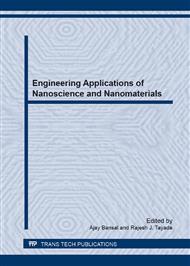p.1
p.25
p.69
p.85
p.99
p.111
p.139
p.151
Solution Combustion Synthesis: Role of Oxidant to Fuel Ratio on Powder Properties
Abstract:
Solution combustion synthesis technique is one of the novel techniques used to prepare nanoparticles, multi-component ceramic oxides and nanocomposites with properties better than conventionally prepared one and these materials have been used for various applications such as sensors, catalysts, and materials for solid oxide fuel cell (SOFCs). In the present work, the method has been used to prepare nanoparticles of 10 mol% Gd doped ceria (GDC) and Cu and its oxides. The oxidant to fuel (O/F) ratio is found to affect the powder properties and even compositional homogeneity. In glycine-nitrate combustion synthesis of GDC, as revealed by XRD studies, phase pure nanoparticles with crystallite size in the range 9-12nm were obtained for all the O/F ratios. TEM measurements of calcined powder showed hexagonal shaped particles of roughly 20nm size. The exothermicity was increased with the oxidant to fuel ratio resulting in high surface area and soft agglomerates. A slightly lean O/F ratio gives surface area of 73 m2/g and soft agglomerates (D50 = 5.34 mm), which eventually results into high sintering density at low temperature. Raman Spectra of GDC showed a sharp and intense peak at 467 cm−1 which corresponds to CeO2 due to F2g symmetry of the cubic phase. In combustion synthesis of copper nitrate and citirc acid, the compositional homogenity and phase purity was affected by the oxidant to fuel ratio. The combustion at stoichiometric O/F ratio gives Cu nano particles, lean O/F ratio gives nanoparticles of Cu, CuO and Cu2O and rich ratio gives pure CuO nanoparticles. These nanoparticles have been studied with different characterization techniques like XRD, TG-DTA, SEM, TEM, FT-IR and Raman.
Info:
Periodical:
Pages:
85-98
Citation:
Online since:
May 2013
Authors:
Keywords:
Price:
Сopyright:
© 2013 Trans Tech Publications Ltd. All Rights Reserved
Share:
Citation:


